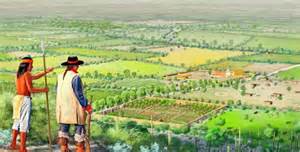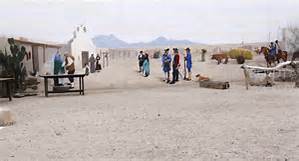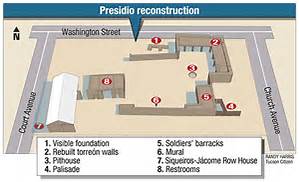The Arizona Apaches had always augmented their livelihood by raiding their more settled neighbors for resources and livestock. After the Spaniards arrived, they competed with the Apaches, becoming another of the Apaches’ targets. In August 1775, Hugo O’Conor, a Lt. Colonel in the service of the King of Spain, authorized the building of a presidio at the site of what is now Tucson. In September 1775, he launched a three-month campaign against the Apaches that killed 130 warriors, captured 104 Apaches and recovered 2,000 horses and mules.
August 1775, Hugo O’Conor, a Lt. Colonel in the service of the King of Spain, authorized the building of a presidio at the site of what is now Tucson. In September 1775, he launched a three-month campaign against the Apaches that killed 130 warriors, captured 104 Apaches and recovered 2,000 horses and mules.
The presidio, which was garrisoned in October 1776, presented an obstacle to the Apaches’ freedom of movement and raiding. In the early 1780s the presidio defenses were weak, the wall was a rickety stockade made of logs. Security was almost nonexistent, the entrance was completely open. The entry had no gate or guardhouse. With a population of less than 400, San Augustin del Tucson was a small outpost on the periphery of the Spanish Empire in North America.
In July 1781, the Spanish settlement at Yuma crossing on the Colorado River was wiped out by Quechan Indians. About 100 Spanish men were killed, the raiders carried off 74 women and children. As word of the Spanish calamity spread, the Apaches began thinking about launching an attack of their own. Destroying the Tucson presidio would remove the Spanish base for retaliatory attacks, making the Apaches more secure.
carried off 74 women and children. As word of the Spanish calamity spread, the Apaches began thinking about launching an attack of their own. Destroying the Tucson presidio would remove the Spanish base for retaliatory attacks, making the Apaches more secure.
Late in the morning of May 1, 1782, the Apaches attacked San Augustin del Tucson with a force that has been estimated at between 300 and 600. This attack was different, it was not a raid to seize domestic animals or supplies. The focus of the assault was on the inhabitants of the Spanish presidio and adjacent Pima Indian town. The goal was to wipe both of them out.
The Apaches approached in two war parties. They attacked the presidio at the same time as they struck the Pima pueblo next to the San Augustin del Tucson mission at foot of Sentinel Peak (modern “A” mountain) on the other side of the river. The attack caught the Spaniards by surprise. Of the 67 soldiers and five officers stationed at the Tucson presidio, only about 20 were present at the time of the attack.
mission at foot of Sentinel Peak (modern “A” mountain) on the other side of the river. The attack caught the Spaniards by surprise. Of the 67 soldiers and five officers stationed at the Tucson presidio, only about 20 were present at the time of the attack.
As the startled Spaniards grabbed for their weapons, the presidio’s entryway was defended by an officer with a musket and his Indian servant armed with a bow and arrows. The pair had an advantage, they were firing at opening in the stockade from a rooftop inside the fort. Soon other Spanish soldiers sprinted across the ground firing at the attackers attempting to come through the entryway. For some unknown reason, the Apaches concentrated on storming the entry, they made no effort to scale the stockade.
Back in those days, the Santa Cruz River flowed all year long. To reach the Pima village, the Apaches had to cross a bridge. Reacting quickly to the threat, two  Spaniards and number of Pima Indians rushed to defend the bridge, effectively blocking the attempt to cross. The fighting continued for about two hours with the attackers making little headway. It came to an end when the Spaniards in the presidio managed to get a cannon into action. After it was fired, the Apaches broke off the attack.
Spaniards and number of Pima Indians rushed to defend the bridge, effectively blocking the attempt to cross. The fighting continued for about two hours with the attackers making little headway. It came to an end when the Spaniards in the presidio managed to get a cannon into action. After it was fired, the Apaches broke off the attack.
The Spaniards later confirmed that the Apaches lost eight warriors killed, six at the presidio and two at the bridge. An unknown number of Apache wounded had been removed by the attackers during the course of the fighting. The Spanish and Pima defenders suffered two wounded and one killed. The use of firearms gave the Spaniards an advantage in the battle because of their scarcity in the region. The Apaches had not acquired any firearms by the time of the 1782 attack.
In the battle’s aftermath, the Spaniards made haste to replace the rickety log stockade with stout adobe walls. They were constructed in slightly over a year, about 750 feet long on each side. In March 1784, a large Apache force attacked again. This time, the raiders ignored the presidio and pueblo, they got away with five hundred horses.
about 750 feet long on each side. In March 1784, a large Apache force attacked again. This time, the raiders ignored the presidio and pueblo, they got away with five hundred horses.
By 1789, the presidio had become a formidable defensive base. It had thick adobe walls, stout wooden gates and bastions on opposite corners. Over time, the Tucson presidio performed as the Spanish had planned and as the Apaches feared. During the turbulent years of warfare, it was never abandoned, it always remained occupied. The uninterrupted period of human occupation makes Tucson unique. It is the only city in Arizona to be inhabited continuously since the time it was founded by the Spanish.
Discover more from Blog for Arizona
Subscribe to get the latest posts sent to your email.
